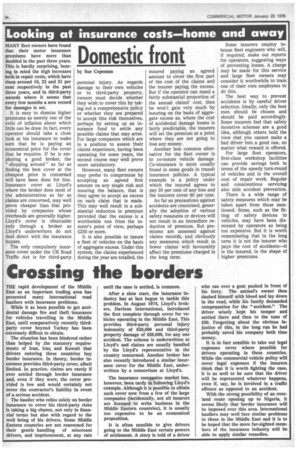Domestic front
Page 36

If you've noticed an error in this article please click here to report it so we can fix it.
by Sue Copeman MANY fleet owners have found that their motor insurance premiums have more than doubled in the past three years. This is hardly surprising, bearing in mind the high increases both in repair costs, which have risen around 18, 22 and 31 per cent respectively in the past three years, and in third-party awards where it seems that every few months a new record for damages is set.
It is easy to dismiss higher premiums as merely one of the evils of inflation about which little can be done. In fact, every operator should take a close look at his insurance to make sure that he is paying an economical price for the cover that he requires. If he is employing a good broker, the "shopping around" as far as finding the best cover at the cheapest price is concerned will have been done for him. Insurance cover at Lloyd's where the broker does most of the administration as far as claims are concerned, may well prove cheaper than that provided by companies whose overheads are generally higher. Lloyd's cover is obtainable only through a broker as Lloyd's underwriters do not deal direct with the insurance buyers.
The only compulsory insurance cover under the UK Road Traffic Act is for third-party personal injury. As regards damage to their own vehicles or to third-party property, owners must decide whether they wish to cover this by taking out a comprehensive policy or whether they are prepared to accept this risk themselves, perhaps by setting up an insurance fund to settle any possible claims that may arise. For large companies which are in a position to assess their claims experience, having been operating for some years, the second course may well prove more satisfactory.
However, many fleet owners may prefer to compromise by accepting an agreed first amount on any single risk and insuring the balance, that is they agree to accept an excess on each claim that is made. This may well result in a substantial reduction in premium provided that the excess is a worthwhile one from the insurer's point of view, perhaps £250 or more.
It is also possible to insure a fleet of vehicles on the basis of aggregate excess. Under this system, the claims experienced during the year are totalled, the insured paying an agreed amount to cover the first part of the cost of the claims and the insurer paying the excess. But if the operator can stand a fairly substantial proportion of the annual claims' cost, then he won't gain very much by insuring on the basis of aggregate excess as, where the cost of accidental damage losses is fairly predictable, the insurers will set the premium at a point where they are not going to lose any money.
Another less common alternative for the fleet owner is to co-insure vehicle damage. Co-insurance is more usually found in some goods in transit insurance policies. A typical example is a policy under which the insured agrees to pay 20 per cent of any loss and the insurers cover 80 per cent.
As far as precautions against accidents are concerned, generally the adoption of various safety measures or devices will not result in an immediate reduction of premium. But premiums are assessed against claims records, and obviously any measures which result in fewer claims will favourably affect the premiums charged in the long term. Some insurers employ inhouse fleet engineers who will, if required, make out reports for operators, suggesting ways of preventing losses. A charge may be made for this service and large fleet owners may consider it worthwhile to train one of their own employees to do this.
The best way to prevent accidents is by careful driver selection. Ideally, only the best men should be chosen and should be paid accordingly. Some insurers feel that safety incentive schemes are a good idea, although others hold the view that you cannot make a bad driver into a good one, no matter what reward is offered.
For large fleet operators, first-class workshop facilities can provide savings both in terms of the speedy turn-round of vehicles and in the overall cost of repair work. Regular and conscientious servicing also aids accident prevention.
There is a wide range of safety measures which may be taken apart from those mentioned. Some, such as the fitting of safety devices to vehicles, may have been dismissed by operators as being too expensive. But it is worth remembering that in the long term it is not the insurer who pays the cost of accidents—it is the insured, in the shape of higher premiums.
















































































